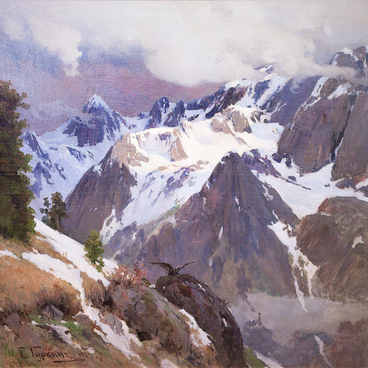Russian artist Anton Bruni was born in the Italian-speaking area of Switzerland. He belonged to a well-known family; his father was an engraver.
Bruni was educated in Italy, in the Academy of Saint Luke in Rome, then he worked as a jeweler and, by the age of forty, moved to Russia. During the Napoleonic Wars Bruni served as a captain of Swiss troops, which fought against the French, and in Alexander Suvorov’s army.
Bruni wrote that he had to leave Milan in 1807: he was threatened with imprisonment for his loyalty to his native Switzerland. When he moved to Russia, he got a position of a “master of painting and sculpture at Tsarskoe Selo Palaces” and taught drawing at the Imperial Lyceum.
Anton Bruni started a great dynasty of famous Russian artists. His son Fyodor was the rector of the Academy of Fine Arts and Alexander, Fyodor’s great-nephew, was the architect of the Main Palace Administration of Saint-Petersburg, Tauride Palace, Mariinsky and Alexandrovsky hospitals. Mastery secrets were passed down in the family from father to son.
Researchers point out that in the end of 18th — early 19th century there were several families of hereditary artists in Russia, for example the Scotti family and the Bruleau family. Some artists were better at creating landscapes, others drew ornamental or complex compositions. Such collaboration was very profitable when it came to interior design of various estates.
Anton Bruni created history paintings, decorative panels, portraits and compositions similar to genre art. When he became an academician at the Academy of Fine Arts he worked as an artist and restorer at Tsarskoe Selo and the Mikhailovsky Palace.
In 1821–1823 the artist worked at the invitation of Prince Ivan Baryatinsky at the Maryino Estate, Kursk Governorate, where he completed murals on walls and ceilings at one of the most luxurious palaces of the Russian province. Bruni worked in the grisaille technique, fashionable at that time in interior décor, which imitated low-relief sculptures on canvas. The artist and his assistants depicted hundreds of figures of ancient heroes, gods, putti (chubby male children, usually with wings) and cupids.
The word ‘grisaille’ means ‘grey’, but works created in this technique could be of any color. More often grisaille is used in interior design, for example, low-relief. The realism of the picture is obtained by thorough drawing of shades, highlights, details. Thus, the finished work looks like a marble statue.
Bruni depicted angels which allegorically symbolize seasons. Cupids on the panel which is owned by the museum demonstrate summer fruits. The artwork presented at the exhibition is one of the few surviving decorative paintings of the master. In Kursk four more grisaille paintings survived in the palace, which became a sanatorium after the revolution. Three grisaille paintings are currently housed in the Kursk Art Gallery collection, including ‘Cupid with a basket of flowers’, which differs from the cupid on the right in minor details.
Bruni was educated in Italy, in the Academy of Saint Luke in Rome, then he worked as a jeweler and, by the age of forty, moved to Russia. During the Napoleonic Wars Bruni served as a captain of Swiss troops, which fought against the French, and in Alexander Suvorov’s army.
Bruni wrote that he had to leave Milan in 1807: he was threatened with imprisonment for his loyalty to his native Switzerland. When he moved to Russia, he got a position of a “master of painting and sculpture at Tsarskoe Selo Palaces” and taught drawing at the Imperial Lyceum.
Anton Bruni started a great dynasty of famous Russian artists. His son Fyodor was the rector of the Academy of Fine Arts and Alexander, Fyodor’s great-nephew, was the architect of the Main Palace Administration of Saint-Petersburg, Tauride Palace, Mariinsky and Alexandrovsky hospitals. Mastery secrets were passed down in the family from father to son.
Researchers point out that in the end of 18th — early 19th century there were several families of hereditary artists in Russia, for example the Scotti family and the Bruleau family. Some artists were better at creating landscapes, others drew ornamental or complex compositions. Such collaboration was very profitable when it came to interior design of various estates.
Anton Bruni created history paintings, decorative panels, portraits and compositions similar to genre art. When he became an academician at the Academy of Fine Arts he worked as an artist and restorer at Tsarskoe Selo and the Mikhailovsky Palace.
In 1821–1823 the artist worked at the invitation of Prince Ivan Baryatinsky at the Maryino Estate, Kursk Governorate, where he completed murals on walls and ceilings at one of the most luxurious palaces of the Russian province. Bruni worked in the grisaille technique, fashionable at that time in interior décor, which imitated low-relief sculptures on canvas. The artist and his assistants depicted hundreds of figures of ancient heroes, gods, putti (chubby male children, usually with wings) and cupids.
The word ‘grisaille’ means ‘grey’, but works created in this technique could be of any color. More often grisaille is used in interior design, for example, low-relief. The realism of the picture is obtained by thorough drawing of shades, highlights, details. Thus, the finished work looks like a marble statue.
Bruni depicted angels which allegorically symbolize seasons. Cupids on the panel which is owned by the museum demonstrate summer fruits. The artwork presented at the exhibition is one of the few surviving decorative paintings of the master. In Kursk four more grisaille paintings survived in the palace, which became a sanatorium after the revolution. Three grisaille paintings are currently housed in the Kursk Art Gallery collection, including ‘Cupid with a basket of flowers’, which differs from the cupid on the right in minor details.



